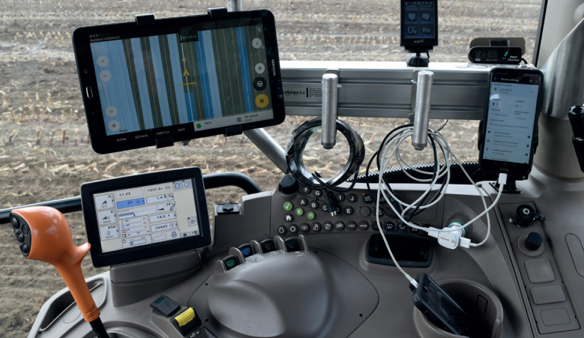Resources
How a GPS App Helps Farmers Work on Different Types of Land

Modern farms often manage fields with varying terrain, sizes, and crop characteristics. Effective work under such conditions requires both high precision and flexibility in machinery operation. GPS apps enable farmers to adapt to the unique features of each field, providing accurate navigation, resource savings, and consistent quality of agricultural operations. Get started with FieldBee GPS — start using professional precision farming solutions today.
Below, we take a closer look at how GPS navigation helps farmers work efficiently across different types of farmland.
Flat, Large Fields
On flat fields with uniform terrain, the main goal is to maximise the efficiency of large-scale operations. A GPS app allows farmers to plan ideal routes with minimal turns and headlands, which is particularly essential during operating wide implements. Accurate trajectory guidance eliminates overlaps and skips, reduces fuel consumption, and saves seed and agrochemicals. Consistent working widths and well-organised routing significantly increase daily machinery productivity.
Hilly and Uneven Terrain
Working on hillsides and slopes is complicated by unstable satellite signals and difficulties in maintaining precise machine guidance. GPS apps with multi-constellation support (GPS, GLONASS, Galileo, BeiDou) and RTK correction ensure consistent accuracy even on challenging terrain. The equipment follows the planned trajectory precisely, preventing sideways implement drift, uneven seed placement depth, and loss of planting area. This is vital for uniform crop development and for preventing soil erosion.
Small and Irregularly Shaped Fields
On smaller fields with irregular shapes, the risk of errors during turns, overlaps, and skips increases. A GPS app helps plan routes accurately even in fields with complex layouts, minimising manoeuvres, precisely calculating headland turns, and saving time on every operation. For farmers managing multiple dispersed fields, quick data transfer between plots and the ability of saving individual field settings are also valuable features.
Orchards, Vineyards, and Perennial Crops
In orchards and vineyards, extremely high precision is essential, as operations take place in narrow rows where even a slight deviation can damage the plants. A GPS app ensures stable positioning of machinery within tight row spaces, enabling safe cultivation, fertiliser application, spraying, and pruning. This reduces root system trauma, preserves planting material, and supports the long-term productivity of the plantation.
Shelterbelts, Fields with Obstacles and Barriers
Working near tree lines, water bodies, buildings, or power lines requires navigation systems that can handle local signal interference. GPS apps with advanced signal filtering and guidance algorithms allow equipment to maintain precise lines even with partial signal obstruction. This helps maintain accurate working widths, prevent overlaps, and avoid resource waste in complex areas.
Arid and Irregularly Irrigated Fields
In dry regions or fields with limited irrigation, even moisture distribution and precise resource application are especially critical. A GPS app allows farmers to implement variable-rate seeding and fertilisation schemes, adjusting machinery operations to field microzones with differing moisture levels and fertility. This enables more efficient use of scarce water resources, reduces soil stress, minimises plant drought stress, and helps maintain stable high yields even in challenging climates.

-

 Resources4 years ago
Resources4 years agoWhy Companies Must Adopt Digital Documents
-

 Resources3 years ago
Resources3 years agoA Guide to Pickleball: The Latest, Greatest Sport You Might Not Know, But Should!
-

 Resources3 months ago
Resources3 months agoTOP 154 Niche Sites to Submit a Guest Post for Free in 2025
-

 Resources3 months ago
Resources3 months ago50 Best AI Free Tools in 2025 (Tried & Tested)